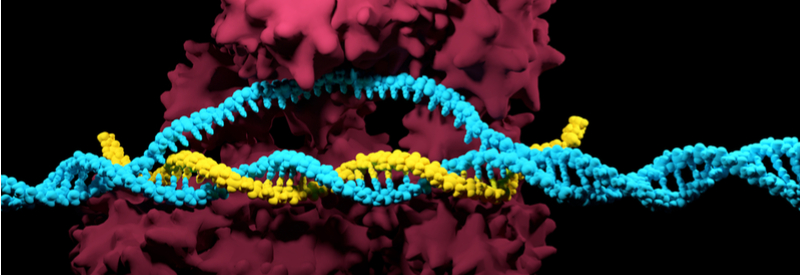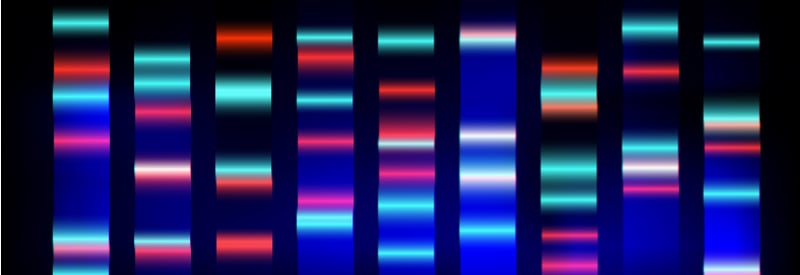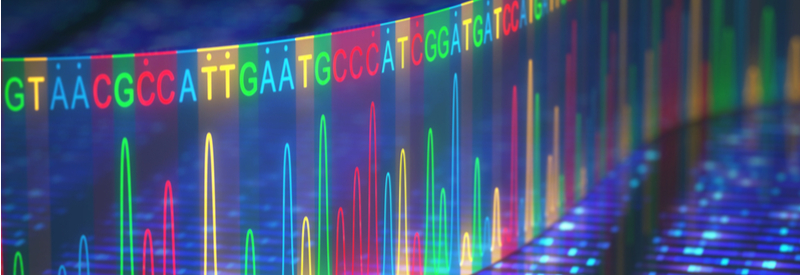The novel spin given to some traditional and established technologies can be astounding. They might have been around for decades, applied in the same way over and over again, and yet, at some point, somebody comes along, observes it in a new light and gives it a brand new polish.
One such technology is called molecular combing or chromosome combing. It has been around since the early 1990s and is a well-established DNA analysis tool. In three separate steps, DNA is extracted from cells and its strands are stretched over a silanized surface, allowing it to be tagged using fluorescent probes. These tags attach to specific DNA sequences and a scanner can automatically detect certain patterns, such as the markers of different diseases.
A golden coat for a long-lasting effect

Molecular combing of DNA is a clever concept that enables the direct visualization of our genetic material at a molecular level. It has found applications in a number of research and diagnostic areas, including the study of DNA replication, genetic mutations and drug candidates, as well as the diagnoses of a number of cancers.
But how do you make a well-established technology that has been around for decades essential and necessary for future research and diagnostics? Founded in 2004, Genomic Vision has expanded the application of molecular combing to suit the future life sciences industry.
The company, which started the commercialization of their combing technology in 2014, focuses on three core areas: gene editing and genome manipulation; DNA replication and the cell cycle; and cancer detection and genetic disorders. In these areas of interest, Genomic Vision has recently started collaborations with the pharmaceutical companies AstraZeneca and Editas Medicine.

Checking in on CRISPR-Cas9
Together with Editas, for instance, Genomic Vision is exploring the field of genome editing – CRISPR-Cas9 to be precise. The collaboration is addressing the fact that there is still a need to control the quality and efficacy of the enzyme and the genomic region it is cutting into.
“Editas is working on cutting the DNA in specific regions of the genome and introducing new genes or modifying the DNA in that region,” explains Aaron Bensimon, President and CEO at Genomic Vision.
“With our combing technology we then stretch the edited DNA molecules and add fluorescent markers. That way we can measure the efficacy of the enzyme and check whether it has cut at the right place. It is a type of quality control.”

Disrupting cell cycles with molecular combing
In the area of DNA replication and the cell cycle, Genomic Vision entered into a collaboration with AstraZeneca in May 2017. “We have developed an assay that enables the quantitative monitoring of DNA kinetics within cells,” Bensimon says. An assay, at that, which can provide useful information for drug development in preclinical stages.
The two companies are working in the field of oncology. By targeting DNA damage responses (DDR) they are hoping to create novel cancer treatments that influence the cell cycle and replication of tumour cells. Genomic Vision’s molecular combing technology will play an essential part in the evaluation and analysis of the kinase inhibitor WEE1, which negatively influences the cell cycle of cancer cells by preventing DNA replication.

AstraZeneca is now observing how inducing stress on a replicating cell can contribute to the anti-tumor efficacy of WEE1. Here, molecular combing will determine the effects of replication stress induced by the kinase inhibitor.
In future, the two companies are planning to combine Genomic Vision’s scientific understanding of replication stress with AstraZeneca’s portfolio of DDR inhibitors, as understanding the mechanistic differences between various DDR inhibitors would boost the development of novel personalized drugs.
Discovering genetic diseases and cancer in genomic rearrangements

Genomic Vision’s third focus area is the detection of cancer and other genetic disorders. “Our key goal is to develop DNA-based tests for early cancer detection and genetic diseases, such as breast cancer, cervical cancer or muscular dystrophy,” explains Bensimon.
The company’s molecular combing technology is already able to create a molecular pattern, called the Genomic Morse Code (GMC), which can be read like a barcode. A specific scanner can detect genomic rearrangements or mutations, such as deletion, inversion, copy number variation or translocation.
A bright future ahead

Bensimon elaborates on Genomic Vision’s future plans: “We are currently finalizing other collaborations in the field of gene editing and cell replication. We want to explore other types of CRISPR and start working with more partners.”
Also, the company wants to look into entering the fields of agrar science, food testing and environmental examinations. “As long as there is DNA to comb, we will have something to do,” concludes Bensimon.
Intrigued by Genomic Vision’s new spin on molecular combing? Then check out their website and see what they do for yourself!





